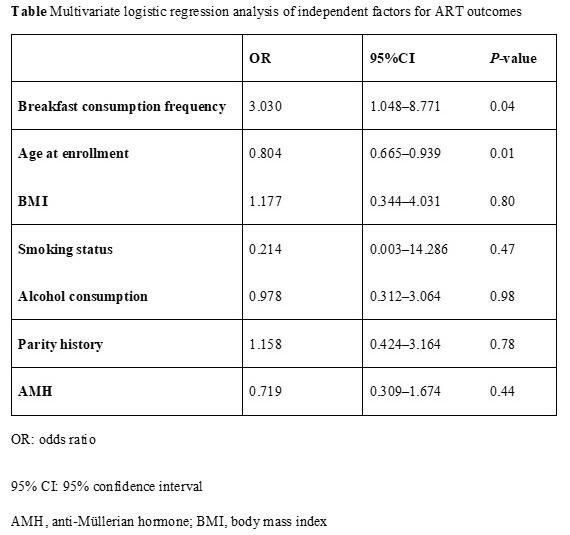A research group led by Professor and Chairman Hirotaka Nishi and Associate Professor Masanori Ono of the Department of Obstetrics and Gynecology at Tokyo Medical University, in collaboration with Assistant Professor Shunichiro Orihara of the Department of Health Data Science at Tokyo Medical University and Kanazawa University and Kyoto Notre Dame University, announced their research findings that women who consumed breakfast daily had a higher live birth rate and a lower miscarriage rate after assisted reproductive technology (ART) treatment compared than those who did not. Daily breakfast intake is expected to improve ART outcomes. These results were published in the international journal Nutrition on August 14.

Provided by Tokyo Medical University
The biological rhythms of organisms are formed by the circadian expression of clock genes, which regulate the expression of various target genes. These rhythms are controlled by the central clock in the suprachiasmatic nucleus of the hypothalamus and peripheral clocks in cells throughout the body. Abnormalities in clock function have been reported to increase the risk of developing diabetes, dyslipidemia, hypertension, and depression.
Recent studies have revealed that work patterns involving frequent night-shift work increase the risk for ovulation disorders, infertility, and recurrent pregnancy loss. Although treatment outcomes in reproductive medicine have improved with the development of freezing technology and other techniques, new intervention approaches are needed to further improve treatment outcomes.
Animal studies have demonstrated the effects of dietary intake on reproductive function. However, effects of human lifestyle factors on pregnancy outcomes have not been studied in detail. In this study, the research group examined the association between breakfast intake frequency and ART outcomes in patients with infertility. Specifically, 101 women with infertility and no histories of stroke, heart disease, cancer, or diabetes (type 1 or 2) were surveyed using questionnaires between February 2022 and January 2024. Multivariate analysis of ART outcomes was performed after adjustment for potential confounders, including age, smoking status, alcohol consumption status, body mass index (BMI), anti-Müllerian hormone (AMH) levels, and history of pregnancy and delivery.
The results showed that the group of women consuming breakfast daily (6 or 7 times/week) (n = 53) had a higher live birth rate and a lower miscarriage rate after ART treatment than the other group (0-5 times, n = 48). The rates did not correlate with smoking status, alcohol consumption status, AMH, which is a measure of the quantity of remaining oocytes, or BMI.
Ono said, "We have been continuing our research to clarify the relationship between the circadian rhythm of the uterus and reproductive function and to provide preconception care and health management based on scientific evidence from chronobiology. In the analysis of uterine clock gene expression and its regulation by feeding, we tested whether clock genes have an oscillating rhythm of approximately 24 hours in the uterus. We found that the uterine peripheral clock was regulated by feeding under conditions of time-restricted feeding. We further examined the association between clock genes and perinatal diseases in mice with modifications to the uterus-specific clock gene Bmal1 (Bmal1 KO) and found that pregnant Bmal1 KO mice experienced miscarriages and stillbirths. Based on these basic research data, we conducted the present clinical study. The study results revealed that women who consumed breakfast daily had a higher live birth rate and a lower miscarriage rate after ART treatment than those who did not. Based on the results of this study, the patient's self-intervention of daily breakfast consumption is expected to contribute to improving ART outcomes."
Journal Information
Publication: Nutrition
Title: Impact of daily breakfast intake on the outcomes of assisted reproductive technology procedures
DOI: 10.1016/j.nut.2024.112555
This article has been translated by JST with permission from The Science News Ltd. (https://sci-news.co.jp/). Unauthorized reproduction of the article and photographs is prohibited.




